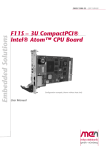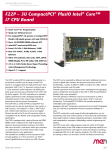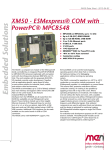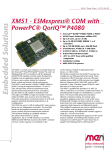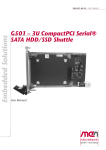Download Embedded solutions for Rail, Road, Air and Sea
Transcript
Embedded Solutions for Rail, Road, Air and Sea www.men.de Worldwide Availability Subsidiaries and Distributors in over 20 Countries Rugged Computer Boards and Systems for Harsh, Mobile and Mission-Critical Environments Reliability Safety Availability Ruggedness 4 Gain New Experiences 5 Content Who We Are Expertise Target Markets Product Lines 8 About MEN 12 Core Competencies 18Rail 42CompactPCI/PlusIO/Serial 24Road 44VMEbus 30Air 46 Safe Computers 36Sea 48 Box & Display Computers 50Computer-on-Modules 52 Networks & Connectivity 54 Mezzanine I/O 56Enclosures 58PSUs 60 Custom Design 62Partners Contact 63 Ordering Information 6 7 About MEN Innovation Flexibility Future Safety Quality Environmental Protection Tailored Solutions Social Responsibility 8 Step Into the Future 9 About MEN “Founded in 1982, MEN Mikro Elektronik develops, produces and qualifies computers for extreme environments – where ruggedness and reliability count. Our electronics are embedded in vehicle and wayside control, supervision, communication, infotainment, security and test systems. Our expertise makes us successful in several markets: railways and ground transportation, civil avionics, shipbuilding, commercial vehicles, agricultural and construction machines. More than 250 highly motivated employees, located in Germany, France and the USA, are looking forward to partnering with you worldwide.” Environmental Protection We continuously improve our environmental protection practices by avoiding unnecessary environmental impact and strictly following environmental laws. Because we want to manufacture our products without harming the people that manufacture them we avoid hazardous materials wherever possible, use energy responsibly, and minimize our waste. Social Responsibility We follow an open and honest policy towards our employees and want to motivate them to treat each other with the same respect. At the same time, we encourage all members of the MEN family to take that tolerance and solidarity home with them each day. Training & Education By offering vocational training and opportunities for continuing education, we want to make sure that young, old and socially disadvantaged people have equal chances in their professional careers. We want to offer all our employees a safe job within the company. We are proud to contribute to the economic competitiveness of our area (Nuremberg, Germany). Manfred Schmitz, Chief Technical Officer MEN Mikro Elektronik® Udo Fuchs, Chief Financial Officer MEN Mikro Elektronik® Headquarters Nuremberg, Germany EN 9100 EN 9001 EN 14001 ISO 9001:2008 ISO 14001:2005 EN 9100:2003 MEN Mikro Elektronik® is the first German company – and one of only ten entities worldwide – certified according to both the EN 9100 (aerospace) and IRIS (transportation) quality management systems. 10 Business Ethics Our business ethics and daily conduct with customers, partners and employees are determined by the ten principles in the areas of human rights, labour, environment and anti-corruption of the UN Global Compact Initiative. More information under: www.men.de/000254 11 Core Competencies Lifecycle Management FPGA Technology Know-How In-House Environmental Test Lab Rugged Electronics Quality Management Systems Safe Electronics COTS and Custom Design In-House Production Complete System Configurations 12 Empower Your Senses 13 Core Competencies Rugged Electronics Complete System Solutions Rugged electronics imply safe and reliable operation of a computer board or system in harsh environments. Electronic components in mobile applications need to meet the most severe environmental requirements. Our boards and systems are developed to meet requirements like extended operating temperature from -40 to +85°C as well as shock, bump and vibration. Also, the electronics have to be protected against chemicals and humidity. Whether developing a 19“ system, wall-mount, stand-alone, DIN rail or an entire custom solution, we guarantee the overall operation of each system, minimizing integration efforts and the handling costs on the client’s side. The concept of receiving the entire solution from MEN – a single supplier responsible for the whole system – makes project management easier for the client and allows us to tailor the system to the requirements. We are also responsible for selecting the right third-party components and deciding if it is necessary to develop additional components. Safe Electronics Failures in safety-critical electronic systems can result in loss of life, substantial financial damage or can severely harm the environment. System considerations include safety-critical characteristics, reliability questions and error behavior modes according to IEC and EN standards. MEN has the long-standing expertise to develop, configure and build redundant system architectures that deliver the basis for certification according to SIL and DAL safety levels and to offer functionally safe board-level products. Our Design Center Software, hardware and IP-core design are verified, achieved and validated according to the V-Model and the individual application’s safety requirements. Reliability of the electronics are evaluated and proven by environmental type tests in accordance with market standards like EN 50155 or DO-160. Obsolescence m anagement guarantees a defined product life-cycle and replacement procedure. Our RAMS management identifies, analyzes, prioritizes and solves all possible risks in technical, financial or personnel-related respects. Our Environmental Test Lab With our own environmental laboratory, we perform all the necessary climatic tests to not only make sure that the electronics fulfills the requirements, but to gain pre-qualification status for the products in accordance with specific vertical market standards. This includes testing regarding temperature, shock and vibration as well as EMC. Other inspections that can be carried out are high-voltage tests and infrared inspection with an IR camera as well as HASS (Highly Accelerated Stress Screening) and HALT (Highly Accelerated Life Test) to detect possible weaknesses in electronics and mechanics. Our In-House Production and Test High-quality manufacturing in Germany at an affordable cost is possible. Our fully automated in-house production line consists of components optimized for a cost-effective high-production diversity. Complete traceability is guaranteed through time stamping during the production process and is integrated into the organization‘s overall data system. The test department performs a 100% functional test of each board – on boundary scan and/or in-circuit machines, depending on the product. Unit inspections, e.g. high voltage tests, are done when required by the product. Burn-in tests are carried out per customer request. More information under: www.men.de/000255 14 15 Target Markets Reaching High Aims 16 17 Rail COTS Solutions up to SIL 4 Modern trains have many functions directly controlled by computer systems, such as the train drive and speed control as well as the control of doors, lighting or heating. As environments are often harsh and narrow, computers in railway applications must be robust and compact. The systems are typically networked by fieldbuses (CAN bus, MVB/WTB, ProfiNet), and increasingly by safe Ethernet variants. Compliance with at least parts of EN 50155 is mandatory. In addition, many applications are safety-critical and demand safety levels from SIL 1 to SIL 4, often resulting in redundant systems with defined error handling. These include (onboard) train protection, the safe operation of signals and switches and other vital functions in wayside control and traffic management (e.g., in accordance with the European ERTMS or the American PTC system). Locomotives Railcars High Speed Trains Metro Vehicles Computers for train communication are mission-critical, transmitting data and voice information between the train, the wayside equipment and control center. They are also used for passenger convenience (information and entertainment), with up-to-date information loaded to onboard servers and transferred to displays. And, they support security initiatives (surveillance systems), recording camera data streams to video recorders and transmitting data to the control center. With in-vehicle communication mostly based on standard Ethernet, the outside infrastructure is connected using different wireless standards (GSM-R/P, GPRS, Edge, UMTS, HDSPA, LTE, WLAN). City Rail Vehicles Wayside Control and Protection 18 19 © MEN Mikro Elektronik® GmbH, August 2012. Automatic Train Operation, Protection & Control Content Server MVB/WTB Interface Board Computer Rugged Diagnosis Box Rugged Ethernet Switch Ethernet Backbone Ethernet Consist Network Vehicle Bus WTB Gateway Wire Train Bus Control of Vital Functions 20 Infotainment Display Computer Digital Video Recorder Wireless Access Point Security Display Computer Train Guard & Driver HMI Copyright © MEN Mikro Elektronik® GmbH, September 2012 Rail Applications Wireless Service System Train Protection with SIL 4 Computer This CompactPCI® PlusIO system takes care of all data transfers between individual trains and the railway company‘s central servers via UMTS and/or WLAN, e.g., pending seat reservations, information about the current trip including potential connections and other services. It also provides GPS functionality, optimizing available passenger information within the train at any given moment. In this application, a COTS VMEbus single board computer (SBC) provides the safety of a triple redundant 2oo3 system, but is programmed like a single CPU/memory system. Two identical SBCs are then connected to a cluster, forming a safe I/O concept. This safe computer for SIL 4 operation controls interlocking blocks and other wayside equipment. Driver Desk Communication with ATO Diagnosis and Service The driver desk computer integrated with a human-machine interface directly communicates with the automatic train operation (ATO) system and displays present and maximum speed, the movable distance and the isolation section. The operator inputs driving data for transmission to the ATO system. The conduction-cooled system is based on an ESMexpress® COM. 22 This conduction-cooled diagnosis system monitors and logs data of the motor functions, the doorclosing mechanisms and other functions reported to the depot during travel. The rugged CompactPCI®based system uses M12 connectors for the Ethernet channels and is equipped with an intelligent power supply for system shutdown. Automatic Train Operation Train Surveillance Systems This control and monitoring system for a driverless underground application provides a response channel that allows the permanent transmission of the vehicle‘s status back to the control center. The redundant CompactPCI® computer systems consist of five independent units forming two 1oo2 systems and one separate system for communication and data storage. Each train system includes a combination of four digital video recorder units and two video display servers, all housed in an individual CompactPCI® rack. The digital video recorder unit captures closed circuit television (CCTV) images to disk and stores event data collected from the set. The video display server enables real-time display of CCTV images on the set. 23 Road Buses, coaches, trucks and other commercial vehicles as well as construction and agricultural machines have many functions directly controlled by computer systems that also need to communicate with the outside world. Most of these environments are harsh, so the computers must be very robust and may require e1 automotive certification. In addition to robustness, a small footprint is a must in narrow driver cabins. Control computers for vital functions are typically networked by fieldbuses, like CAN bus, inside the vehicle. Communication computers internally are mainly based on standard Ethernet, while the outside systems are connected using different wireless standards (GSM, GPRS, Edge, UMTS, HDSPA, LTE, WLAN). Dynamic information systems on a public vehicle inform passengers of the current traffic and weather conditions, tour destinations and delays. Access points are required for Internet service or connection to the telephone network. Content servers and video recorders may store movies or camera data from surveillance systems. Buses Precise piloting of construction or agricultural machines (even at night) may require control of cameras, reception of GPS data for navigation and communication with other drivers, with all kinds of data and diagnostics transmitted and exchanged with the company office or farmhouse. Commercial Vehicles Construction Machines Agricultural Machines Mining Machines 24 25 © MEN Mikro Elektronik® GmbH, August 2012. Navigation System Driver Desk HMI Security & Surveillance In-Seat Infotainment Wireless Access Point Ethernet Vehicle Bus Board Computer, Diagnosis 26 Dashboard Display Control Bus Guidance Computer System Rugged Ethernet Switch IBIS Interface SCADA, Telematics Copyright © MEN Mikro Elektronik® GmbH, September 2012 Road Applications Driverless Bus Guidance Computer SCADA System for Buses and Trucks These PowerPC®-based computers control the speed and direction of a driverless bus. The required SIL 4 safety level is achieved through a combination of redundancy, a fail-safe CAN communication infrastructure and a certified operating system/BSP. Every conduction-cooled system consists of three singleboard computers in a redundant 2oo3 configuration, each installed in a different place on the bus to avoid a complete system failure in case of a vehicle collision. This automotive datalogger for data recording and pre-processing sends all information about one or several vehicles (e.g., vehicle position, status or next scheduled maintenance) to the headquarters via UMTS. The fanless, conduction-cooled SCADA system (Supervisory Control and Data Acquisition) is built around a COTS ESMini™ COM and a customized carrier board. Application-specific functions are implemented in the onboard FPGA. Automotive Safety Test Equipment Passenger Information System for Buses This CompactPCI®-based system combines three independent test units in one 19“ rack. When the car is running over the road marking line, the first computer delivers an alarm. The second computer controls the infrared camera for delivering pictures at night, while the third computer is used for data recording. All CPU cards are based on the Intel® multi-core architecture with state-of-the-art computer interfaces to meet the demanding communication and performance requirements in this type of application. This customized intelligent display computer is used on public buses. All interfaces, available at the back of the computer, use rugged D-Sub or M12 connectors. Among other connections, WLAN is used for continuous information updates. The maintenancefree computer operates from -20 to +60°C and comes with e1 automotive certification. 28 Intelligent Farming Mobile Display Units The 12.1“ touch display computer quickly and easily controls farming machines, like combine harvesters. The mobile telemetry control system includes GPScontrolled fleet management, data acquisition, data storage and video display from external cameras. The electronics inside the human-machine interface are based on a standard ESMexpress® COM on a customized carrier board. This rugged 3.5“ box PC acts as a universal control system for all kinds of commercial vehicles and mobile machines and comes with e1 automotive certification. The full custom enclosure is equipped with a display that ranges from 7“ to 15“ and houses a COTS COM on a 3.5“ standard PC size carrier board, which supports Ethernet, USB and UART interfaces as well as graphics and audio I/O. 29 Air COTS Solutions up to DAL-A Airborne functions in commercial or business airplanes are controlled by federated or integrated modular avionics systems. These embedded computers are responsible for vital functions such as flight and engine control, navigation, weather systems or collision avoidance. They are part of the in-flight communication, supervision, security, cabin and passenger information systems, and are more and more frequently connected by safe Ethernet networks like AFDX (ARINC-664). Compliance with the EN 9100 standard is mandatory. Other applications include airport infrastructure ranging from air traffic management and radar to passenger information and security or even test systems for aircraft production. As many of the airborne applications are safety-critical, computer components have to be developed according to DO-254 and DO-178B and have to conform to safety levels DAL-D up to DAL-B or DAL-A. Critical parts have to be proven fit for flight. The computers are fault-tolerant, based on redundancy, availability architecture and built-in test equipment (BITE). Safe avionics computers are mostly developed as custom systems. Certifiable platforms based on COTS solutions are rare. In addition, environments are harsh, and volume and weight are a challenge, so computers must be robust, compact and lightweight. Conductive cooling is the preferred method to cope with extreme temperatures and designs must be SEU-resistant to avoid computing errors caused by cosmic radiation. MEN is certified to EN/AS 9100. Passenger Aircraft Cargo Aircraft 30 31 31 © MEN Mikro Elektronik® GmbH, August 2012. AFDX Endpoint Wireless Access Point Cabin Management Cabin Surveillance AFDX AFDX AFDX Ethernet AFDX AFDX Flight Display Control 32 Safe Airborne Computer Content Server Passenger Information/ In-Seat Entertainment Copyright © MEN Mikro Elektronik® GmbH, September 2012 Air Applications Refueling Monitor Cargo Load Control The IP-based camera system controlled by two identical CompactPCI® system slot cards helps the pilot during this critical refueling maneuver by monitoring the tanker’s approaching speed and the right position of the fuel tank filler hose for the docking process. One of the two SBCs is used as an acquisition computer, with the other functioning as the display and recording unit. This control computer is used for air dropping equipment via parachute or gravity extraction. It is designed, tested, verified and produced in accordance with DO-254 level B and DO-178 level B, based on EN 9100 and the additional GRESS requirements from Airbus. For high operational safety, the 2oo3 system includes onboard triple redundancy for the three PowerPC® processors, the dynamic working memory and the internal structure of the SEU-tolerant FPGA. Earth Image Acquisition Flight Attendant Panel Installed in the plane’s fuselage, this digital aerial camera control system takes pictures from a height of up to 5,000 meters. It is controlled by a state-ofthe-art CompactPCI® Serial SBC, connected via a backplane to two XMC modules plugged onto separate carrier boards. The solution delivers the high processing performance and data throughput required in a mission-critical environment. The robust single-board computer is central to this flight attendant panel, which controls the electrical signals from the plane and serves as a human-machine interface for the crew. It is based on a PowerPC® that already includes the TFT/LCD display and CAN bus functions in the microcontroller. It is qualified according to RTCA DO-160D for mission-critical airborne equipment. Cockpit Display Computer A rugged QorIQ™-based COM module is the heart of all the airborne displays in the cockpit and is designed according to DO-254 for safety level DAL-A. Beside the standard interfaces from the PowerPC®, all application-specific I/O is implemented in the onboard FPGA. The FPGA content as well as the mechanical outfit and the interfaces of the carrier board flexibly vary with the dedicated function of the corresponding display units. 34 Airstrip Security System Control This system consists of two conduction-cooled 10-slot CompactPCI® racks. One is placed near the airstrip, while the other is placed in the control tower. Each rack consists of a CompactPCI® PlusIO CPU board with several M-Modules™ and a PSU. All boards are customized for conduction cooling, enabling operating temperatures from -40 to +85°C. 35 Sea Sea Applications Shipboard Command Desk Command desks on ships use computer systems to control and monitor the engines and electric propulsion, electrical and hydraulic systems, navigation, communication and integrated platform management systems. This application uses 6U VMEbus COTS boards based on the PowerPC® architecture, combined with M-Module™ mezzanine cards (an ANSI Standard) for the integration of analog and binary I/Os and temperature measurement. Shipboard Control and Monitoring System The integrated shipboard control and monitoring system is used for machinery-related propulsion, power generation and distribution as well as data storage on the ship. The rugged, marine-qualified solution uses 3U CompactPCI® systems in multiple configurations, acheived through an Intel® Core™ 2 Duo SBC and a variety of interface cards. Modern passenger and cargo vessels have many functions directly controlled by computer systems that need to communicate onboard, vessel-to-vessel or vessel-to-land. As environments are harsh, the computers must be very robust and may require certification according to German Lloyd. Passenger Information and Entertainment Control computers for vital functions are typically networked by fieldbuses. Onboard communication computers are mostly based on standard Ethernet, while outside communication systems use different wireless standards (GSM, GPRS, Edge, UMTS, HDSPA, LTE, WLAN). Dynamic information systems inform passengers of the current traffic and weather conditions, tour destinations and delays. Access points are required for Internet service or connection to the telephone network. Content servers and video recorders may store movies or camera data from surveillance systems. 36 Passenger Vessels Intelligent display computers with screen sizes up to 23” give passengers orientation schedules and routes, display news of the day and the weather forecast or play movies and music. Content servers based on 3U CompactPCI® are used to store those data and programs. They connect to the screens on the passenger decks via Ethernet and to the station on land using different wireless communication channels to receive up-to-date information while traveling. Cargo Vessels 37 © MEN Mikro Elektronik® GmbH, August 2012. Command Desk Control Wireless Access Point Passenger Infotainment Board Computer, Diagnosis Control Monitoring Machine Control Ethernet Fieldbus Board Computer 38 Rugged Ethernet Switch Copyright © MEN Mikro Elektronik® GmbH, September 2012 39 Product Lines CompactPCI®/PlusIO/Serial VMEbus Safe Computers Box & Display Computers Computer-on-Modules Networks & Connectivity Mezzanine I/O Enclosures and PSUs Custom Design 40 Multiply Your Possibilities 41 CompactPCI®/PlusIO/Serial The CompactPCI® bus has become an established standard for building cost-effective, reliable industrial computers. Users appreciate its modularity, robustness and economic efficiency. We offer a huge range of CompactPCI® I/O cards and CPU cards based on the latest Intel® or PowerPC® architectures, CPU boards featuring industrial functions such as real-time clocks or watchdogs for temperature and voltage control. Mezzanine slots and FPGA technology allow custom extensions of I/O functions. CompactPCI® PlusIO (PICMG 2.30) extends the basic CompactPCI® (PICMG 2.0) standard and offers fast serial communication at the rear: Ethernet, PCI Express®, SATA/SAS and USB. CompactPCI® PlusIO system slot cards can be combined with CompactPCI® Serial peripheral cards while remaining 100% downward-compatible to parallel CompactPCI®. The independent basic standard, CompactPCI® Serial (PICMG CPCI-S.0), introduces a completely new connector, which enables a much higher signal density and supports even higher transmission frequencies of 12 Gb/s and more. It is the ideal basis for communication-intensive, highperformance applications based on modern serial interfaces and proven 19” mechanics. The CompactPCI® Serial architecture, a simple star combined with a full mesh for Ethernet, functions without switches and bridges. G20 – 3U CompactPCI® Serial Intel® Core™ i7 CPU Board • PICMG CPCI-S.0 system and peripheral slot • Intel® Core™ i7, 2.53 GHz • Up to 4 (8) GB DDR3 DRAM soldered, ECC • Front I/O: 2 DisplayPorts, 2 Gb Ethernet, 2 USB 2.0 • Standard rear I/O: 7 PCIe®, 8 USB, 6 SATA, DisplayPort®/HDMI • Intel® Turbo Boost 2.53 – 3.2 GHz, Hyper-Threading, Active Management Technology F21P – 3U CompactPCI® PlusIO Intel® Core™ i7 CPU Board • PICMG 2.30 system slot • Intel® Core™ i7, 2.1 GHz (2nd gen) • Up to 16 GB DDR3 DRAM soldered, ECC • Front I/O: VGA, 2 Gbit Ethernet, 2 USB 2.0 • Rear I/O: 4 PCIe®, 4 USB 2.0, 4 SATA, 1 Gb Ethernet • Intel® Turbo Boost 2.0 - 3.0 GHz, Hyper-Threading, Active Management Technology F11S – 3U CompactPCI® Intel® Atom™ CPU Board • 32-bit 8HP PICMG 2.0 system slot • Intel® Atom™ Z510P, Z530P, Z510PT, Z520PT • Up to 2 GB DDR2 SDRAM • 1 SATA interface via rear I/O • VGA, 2 USB 2.0, PS/2, 1 UART • 1 Gigabit and 1 Fast Ethernet • FPGA for individual user I/O at rear • -40 to +85°C screened or with qualified components See complete product range of CompactPCI®/PlusIO/Serial under: www.men.de/000256 42 43 VMEbus A21B – 6U VMEbus QorIQ™ P1013/P1022 CPU (M-Modules™ ) • Freescale™ PowerPC® QorIQ™ P1013, 800 MHz • Up to dual-core P1022, 1.067 GHz • Up to 2 GB DDR3 DRAM soldered, ECC • microSD™ card and mSATA slot • 2 Gb Ethernet, 1 COM, additional I/O options • 3 M-Module™ slots • -40 to +85°C screened Our 6U VME64 and 2eSST CPU boards are based on Intel® and PowerPC® architectures. In addition to state-of-the-art PC functionality, all CPU boards feature industrial functions such as real-time clocks, or watchdogs for temperature and voltage control. MEN VMEbus solutions are supported by a huge number of industrial I/O boards based on the M-Module™, PMC, XMC and PC-MIP ANSI/ IEC mezzanine standards. A number of boards are equipped with FPGAs for implementation of application-specific functions. A21C – 6U VMEbus QorIQ™ P1013/P1022 CPU (PMC/XMC) • Freescale™ PowerPC® QorIQ™ P1013, 800 MHz • Up to dual-core P1022, 1.067 GHz • Up to 2 GB DDR3 DRAM soldered, ECC • microSD™ card and mSATA slot • 2 Gb Ethernet, 1 COM, additional I/O options • 2 PMC/XMC slots • -40 to +85°C screened A20 – 6U VMEbus 2eSST Intel® Core™ 2 Duo CPU Board • Intel® Core™ 2 Duo L7400 • Core Duo U2500 or L2400 • 1-slot 2eSST VMEbus master and slave • Up to 4 GB DDR2 DRAM soldered • 2 SATA, 1 PATA interface • 1 VGA, 1 Gb Ethernet, 1 USB 2.0 at front • 2 XMC or 2 PMC • PCI Express® 6 x1 links See complete product range of VMEbus under: www.men.de/000257 44 45 Safe Computers A602 – 6U VME64 PowerPC® Safe Computer • Triple redundancy on a single board • 3x redundant PowerPC® 750 CPU, 1 GHz • 3x redundant 512 MB DDR RAM • 2x redundant 256 MB Flash, ECC • Redundant local PSUs • PMC I/O, board management and more via rear I/O • Certifiable up to SIL 4 (with report from TÜV Süd) and DAL-A • -40 to +50°C with qualified components Failures of safety-critical electronic systems can result in loss of life, substantial financial damage or severe harm to the environment. One of the key design elements of a safety-critical system is redundancy. The complex architecture of such systems usually requires equally complex software, resulting in a very time-consuming and expensive development process. With its CompactPCI®- and VMEbus-based CPU cards, MEN has taken redundancy to the board level. Aside from incorporating double or triple processors, the CPU cards feature redundant main memory, local voltage supply, FPGA technology, event logging, conduction cooling options and other safety relevant functions. They have been developed according to DO-254 and EN 50129, are compliant with DO-160 and EN 50155 and are certifiable up to DAL-A and SIL 4. D602 – 6U CompactPCI® PowerPC® Safe Computer • CompactPCI® system slot card, 4 HP • Triple redundancy on a single board • 3x redundant PowerPC® 750 CPU, 1 GHz • 3x redundant 512 MB DDR RAM • 2x redundant 256 MB Flash, ECC • Redundant local PSUs • Certifiable up to SIL 4 (with report from TÜV Süd) and DAL-A • -40 to +50°C with qualified components F75P – 3U CompactPCI® PlusIO Intel® Safe Computer • Dual redundancy on board with: – 2 independent processors Intel® E680T, 1.6 GHz, 0.5 GB DDR2 RAM, each – 1 I/O processor Intel® E680T, 1.6 GHz, 1 GB DDR2 RAM – Each function block with separate supervision • Fail-safe and fail-silent board architecture • Cluster operation to raise availability • Event logging • Certifiable up to SIL 4 • SIL 3 with report from TÜV Süd • -40 to +85°C with qualified components, conformal coating • Full EN 50155 compliance See complete product range of safe computers under: www.men.de/000258 46 47 Box & Display Computers BC50M – Box Computer for Mobile Applications • AMD Embedded G-Series APU • 2 DisplayPorts, up to 2560x1600 each • 2 Gigabit Ethernet, 1 USB 2.0 • WLAN, UMTS, GPS, GSM, HSDPA, EDGE, LTE via 2 PCI Express® Mini Card slots • Slots for 2 UARTs (or 1 IBIS/GPS, 1 CAN) • -40 to +70 (+85)°C operating temperature • Compliant to EN 50155, prepared for e1, up to IP40 MEN box and display computers are based on a flexible, modular concept in terms of processor performance, interface and PSU types as well as display type and size. The design is always accomplished without fans, using conductive cooling to spread the dissipated heat to the outside of the housing. Standard versions comply with the EN 50155, class Tx railway standard and have e1 certification. Based on an innovative concept, our box computers offer the highest flexibility by separating the external interfaces from the main PCB. This way the interfaces can be configured individually and can quickly be adapted to all requirements without additional overhead. SC24 – AMD G-Series SBC for Multi-Display Control • AMD T48N, 1.4 GHz • 2x2 DisplayPort® interfaces • Maximum resolution 2560x1600 • Up to 4 GB DDR3 RAM • 2 Gigabit Ethernet • SD card and mSATA slots • Prepared for -40 to +85°C operating temperature (screened) DC2 – Rugged Panel Computer with Touch • 10.4“ 4:3 TFT LCD with capacitive touch panel • Fanless and maintenance-free design • Intel® Atom™ processor, 1.3 GHz • 2 Fast Ethernet, 2 USB 2.0 • WLAN, UMTS, GPS, GSM, HSDPA, EDGE, LTE optional via PCI Express® Mini Card slot • -40 to +70 (+85)°C operating temperature (-20 to +70°C for display and touch) • e1 certified (automotive), IP65 (front), IP20 (rear) See complete product range of box and display computers under: www.men.de/000259 48 49 Computer-on-Modules XM51 – ESMexpress® COM with PowerPC® QorIQ™ P4080 • Freescale™ QorIQ™ P4080, P4040 or P3041 • 64-bit Power Architecture e500mc CPU • Up to 8 cores, up to 1.5 GHz • Up to 16 GB ECC DDR3 SDRAM, 1 or 2 controllers • 2 Gb Ethernet, 4 USB 2.0, 1 USB client • 2 SATA (3 Gbit/s), 2 PCIe® x1 (5 Gbit/s) • -40°C to +85°C Tcase with qualified components • Conduction cooling Computer-On-Modules (COMs) are complete computers on a plug-on module, perfectly suited for demanding mobile and space-saving applications. Configuring the I/O on an individual carrier board tailors the functionality to the application, saves costs and shortens time-to-market. Our ESMexpress® and ESMini® small form factor boards are available in two different sizes – 95 x 125 mm or an even smaller 95 x 55 mm. Although they are very compact and highly integrated, these rugged COM modules easily handle complex CPUs, including multi-core technology. Providing a fanless, conductive cooling concept, the highly robust and EMC-proof COMs are prepared for a power dissipation of up to 35 W. The CPU PCBs are mounted into a completely enclosed aluminum frame and cover. MM2 – ESMini™ COM with Intel® Atom™ E600 Series • Intel® Atom™ E600 series, up to 1.6 GHz • Up to 2 GB DDR2 SDRAM • 2 PCI Express®, 2 Gb Ethernet • 6 USB 2.0 hosts and 1 USB 2.0 client • 4 UARTs, 1 CAN bus interface • Intel® HD audio • 2 SATA ports • -40°C to +85°C Tcase (screened or with qualified components) • Conduction cooling XC1 – ESMexpress® COM Evaluation Carrier Board • ATX form factor • 1 ESMexpress® slot • 8 PCI Express® connectors • 4 GB USB Flash • 3 SATA • LVDS, DVI • HD audio • 3 Gb Ethernet • 6 USB 2.0 See complete product range of Computer-on-Modules under: www.men.de/000260 50 51 Networks & Connectivity RS1 – IP67 8-Port Managed Ethernet Switch, PoE • Rugged aluminum enclosure (220 x 130 x 70 mm) • Fanless and maintenance-free • 8 Fast Ethernet ports via M12 connectors • 1 Gigabit uplink port via M12 connector • Power over Ethernet (PoE) PSE (ports 1 and 2) • -40 to +70 (+85)°C operating temperature • EN 50155 class Tx (railways) and IP67 compliant • e1 certified MEN offers the whole range of fieldbus and Ethernet, wired and wireless communication standards on different form factors. Whether in CompactPCI® format or as standalone, rack- or DIN rail-mountable units, our easily customizable Ethernet switches are open low-power platforms for harsh environments and operate in temperatures from -40 to +85°C. They are available with rugged M12 connectors as an alternative to RJ45, offering protection up to IP67. In today’s applications, a large variety of wireless communications standards is often required. For instance, a modern train carries electronics that support half a dozen different standards from GSM-R, GSM/GPRS/EDGE and wireless LAN to Bluetooth, UMTS/HSDPA or LTE and Flash-OFDM. So many actively supported standards call for a particularly flexible system design. G211F – 3U CompactPCI® Serial Quad Fiber Optics Interface • 4 optical transceiver channels 1000BASE-SX • Alternatively 2 redundant channel pairs • Full-duplex or half-duplex, depending on transceiver • Fully integrated to comply with IEEE 802.3x • 500 V isolation voltage • -40 to +85°C screened (without transceivers) • PICMG CPCI-S.0 peripheral slot F223 – 3U CompactPCI® PCIe® Mini Card Carrier • 2 PCI Express® Mini Cards (full-/half-size) • For wireless applications (WLAN/WAP, UMTS, GPS, GSM, HSDPA, LTE) • 2 or 3 external antennas per module (reverse SMA) • Up to 18 SIM card slots • -40 to +85°C screened, conformal coating • 32-bit/33-MHz PICMG 2.0 peripheral slot See complete product range of networks and connectivity devices under: www.men.de/000261 52 53 Mezzanine I/O M66 – 32 Binary Inputs/Outputs • 32 inputs 0..32 V or • 32 outputs 12..32 V or • Mixed I/O in groups of 4 • 1.9 A output current per channel • 16 A switching power on 1 M66 • Load on ground • Optical isolation • -40 to +85°C screened versions Using mezzanine cards, modular I/O can be added to any 19” system or on stand-alone SBCs. Our PMC and XMC modules come with computer I/O functions such as graphics, Ethernet, UARTs, FireWire, TTL I/O, memory and fieldbus. Our M-Modules™, an ANSI standard since 1997, are perfectly suited for easily adding any kind of real-world I/O to the system. Using shielded D-Sub connectors and COAX cables, M-Modules™ offer a direct front panel connection providing a clean path for sensitive signals without loss of data or signal quality. Typical M-Module™ functions include instrumentation, process I/O, motion, robotics and various general purpose analog and binary I/O. M199 – FPGA-based Main M-Module™ • Main M-Module™ for USM™ Universal Submodules • 1 USM™ slot • 1 FPGA 33 216 LE (for user-defined I/O and Nios® soft core) • 32 MB DDR2 SDRAM • 8 MB Flash • -40 to +85°C with qualified components P602 – Quad Redundant Gigabit Ethernet XMC • 4 10/100/1000Base-T channels • 2 XMC connectors with 1 x4 PCIe® link on each connector • Alternatively 2 redundant channel pairs • 4 RJ45 connectors at front • Full-duplex and half-duplex • 1.5 kV electrical isolation See complete product range of mezzanine I/O under: www.men.de/000262 54 55 CompactPCI® to CompactPCI® Serial Hybrid Rack for Single Eurocards Enclosures Beside standard enclosures, we also provide you with individual packaging solutions tailored to the needs of your application in terms of performance, functionality, environmental conditions and compliance with norms like EN 50155 or e1. Our product offering comprises rugged stand-alone, wall-mount and DIN-rail standard box and display computers or Ethernet switches as well as individually configured 19“ racks (CompactPCI®/PlusIO/Serial and VMEbus), with conduction or convection cooling, compliant up to IP67. Our systems are tested regarding temperature, humidity, shock, vibration and EMC based on customized requirement specifications. • 19“ rack-mountable • IEEE 1101.10/11 compliance • 4U/84 HP system (incl. 1U fan tray) • 8-slot hybrid backplane • CompactPCI® PlusIO system slot • 4 CompactPCI® Serial (PICMG CPCI-S.0) peripheral slots to the right • 3 CompactPCI® peripheral slots to the left • All slots prepared for rear I/O • 250 W Plug-in PSU 90..264 VAC • 44 HP space for individual extensions CompactPCI® Serial Rack for Single Eurocards • 19“ rack-mountable • IEEE 1101.10/11 compliance • 4U / 84 HP system (incl. 1U fan tray) • 9-slot CompactPCI® Serial backplane according to PICMG CPCI-S.0 • System slot left • Full Ethernet mesh • 460 W ATX PSU, 90..264 VAC • Prepared for slim-line DVD drive CompactPCI® Rack Single Euro with Conduction Cooling • For standard 3U cards within CCA frames • 3-slot 3U backplane • System slot left, horizontal installation • Outline 200 mm x 350 mm x 145 mm • 4 MIL-C-38999 connectors (59 user I/O pins) • PSU 18-32 V, 35 W • -40 to +70(+85)°C operating temperature • IP65 compliant • For -40 to +85°C 3U CCA versions of MEN CompactPCI® and CompactPCI® PlusIO SBCs See complete product range of enclosures under: www.men.de/000263 56 57 PSUs PU3 – 3U 8 HP wide-range PSU for 19” systems, 36-48 VDC • 3U, 8 HP, 19“ rack mountable • Input 36-48 VDC nom. (25.2..60 V) • Max. input voltage range 21.6..67.2 V • Output 3.3 V and 5 V • Power 35 W • -40 to +85°C screened • Conformal coating • Complies with EN 50155 MEN offers different power supply units (PSUs) to meet different voltage inputs from 24 up to 110 VDC in mobile environments. PSUs are controlled by a microprocessor, which supervises up to three external inputs and three external outputs as well as voltage and temperature. Thanks to the onboard intelligence, the PSU can also act as an SMBus slave and communicate with the CPU board via the backplane. This allows the PSU to power on the system at a programmed date or it allows the CPU card to make status polls with regard to error messages, time-out or on/off, for example. The pluggable power supplies in single Eurocard format (3U) were designed for use in 19” systems and need two or three slots (8 or 12 HP). PU4 – 3U 8HP wide-range PSU for 19” systems, 72-110 VDC • 33U, 8 HP, 19“ rack mountable • Input 72-110 VDC nom. (50.4..137.3 V) • Max. input voltage range 43.2..154 V • Output 3.3 V and 5 V • Power 35 W • -40 to +85°C screened • Conformal coating • Complies with EN 50155 PU6 – 3U 12 HP wide-range PSU for 19” systems, 24 VDC • 3U, 12 HP, 19“ rack mountable • Input 24 VDC nom. (16.8..30 V) • Max. input voltage range 14.4..33.6 V • Output 3.3 V, 5 V, 12 V • Power 100 W • -40 to +85°C screened • EN 50155 compliant (holdup time according to Class S2) See complete product range of PSUs under: www.men.de/000264 58 59 Custom Design Expertise The Design Process Design quality is a deciding factor in a product’s reliable operation. The individual steps towards the final product always follow dedicated rules, which are part of an implemented quality management system (DIN EN ISO 9001, EN/AS 9100 and IRIS). Custom Design of Computer Boards and Systems Often the most cost-effective solution results in a custom design – while using as many standard components as possible. Synergy emerges through the mutual development of standard and custom boards and systems. Complete System Solutions Based on In-House Mechanical Design Whether developing a 19” system, wall-mount, stand-alone or DIN-rail, we guarantee overall operation of each system, minimizing the integration effort and the handling cost on the client‘s side. The quality of our systems is ensured by applying traceability through the V-model. Customer Assistance in Configuration of Mission-Critical Systems Computer architectures with safety-critical requirements are very complex. Considerations include safety-critical characteristics and levels (SIL, DAL), reliability questions, error behavior modes, and the major IEC and EN standards – backed by professional safety and risk management. 60 Our RAMS management (Reliability, Availability, Maintainability and Safety) has been installed to avoid costly mistakes in the planning phase. RAMS is used for risk identification and analysis, determination of risk rates and safety as well as for reliability verifications. MEN defines standards and guidelines used during specification, design, verification and validation of a product. In addition to the description of schematic drawings or product naming conventions, these policies contain the design rules for maintainability, testing, robustness, production and product safety. Other regulations refer to things such as the use of design tools, the selection of electronic components or fail-safe and fault-tolerant design constructs. To support customer certification and approvals, additional design assurance methods including traceability, functional tests of all hardware functions or specific environmental tests are applied. Our sales team is ready to find the best solution for you. Contact us! 61 Technology Partners and Memberships Ordering and Shipping Information Altera® Corporation (FPGA Technology) BavAIRia Cluster for innovative aerospace technology in Bavaria • For product ordering numbers, please refer to the corresponding data sheets on MEN‘s website. • Hardware and software user manuals are ready for download from our website. • Software packages are ready for download from our website. • For technical support, please refer to our website. • General terms of delivery and purchasing are available under www.men.de/business/terms-conditions.html. CAN in Automation Industry association promoting the CAN (Controller Area Network) fieldbus standard Legal Information AMD Premier Fusion Partner Program ARINC Aeronautical Radio, Incorporated CNA e.V. Cluster platform for innovative railway technology in Bavaria Contact LGA Nuremberg (certification and validation of products and services) Germany Freescale™ Design Alliance Georg-Simon-Ohm University of Applied Sciences, Nuremberg Green Hills® Software Inc. (INTEGRITY®) Intel® Embedded Communications Alliance MEN Mikro Elektronik® GmbH (Headquarters) Neuwieder Straße 3-7 90411 Nürnberg Phone: +49 911 99335-0 Fax: +49 911 99335-901 [email protected] www.men.de France Schroff® (19“ rack technology) MEN Mikro Elektronik® SA 18, rue René Cassin ZA de la Châtelaine 74240 Gaillard Phone: +33 (0) 450 955 312 Fax: +33 (0) 450 955 211 [email protected] www.men-france.fr Sysgo (PikeOS) USA DQS (certification of MEN´s management system) PCI-SIG Peripheral Component Interconnect Special Interest Group PICMG PCI Industrial Computer Manufacturers Group QNX® (QNX) USB-IF Universal Serial Bus Implementers Forum, Inc. VITA VMEbus International Trade Association Wind River Partner Eco System (VxWorks®) MEN Micro, Inc. 24 North Main Street Ambler, PA 19002 Phone: (215) 542-9575 Fax: (215) 542-9577 [email protected] www.menmicro.com All brand or product names are trademarks or registered trademarks of their respective holders. MEN Mikro Elektronik GmbH reserves the right to make changes without further notice to any products herein. MEN is not responsible for the results of any actions taken on the basis of information in this publication, nor for any error in or omission from the publication; and MEN is not engaged in rendering technical or other advice or services. MEN expressly disclaims all and any liability and responsibility to any person, whether a reader of the publication or not, in respect of anything, and of the consequences of anything, done or omitted to be done by any such person in reliance, whether wholly or partially, on the whole or any part of the contents of this publication. The correct function of MEN products in mission-critical and life-critical applications is limited to the environmental specification given for each product in the technical user manual. The correct function of MEN products under extended environmental conditions is limited to the individual requirement specification and subsequent validation documents for each product for the applicable use case and has to be agreed upon in writing by MEN and the customer. Should the customer purchase or use MEN products for any unintended or unauthorized application, the customer shall indemnify and hold MEN and its officers, employees, subsi diaries, affiliates, and distributors harmless against all claims, costs, damages, and expenses, and reasonable attorney fees arising out of, directly or indirectly, any claim or personal injury or death associated with such unintended or unauthorized use, even if such claim alleges that MEN was negligent regarding the design or manufacture of the part. In no case is MEN liable for the correct function of the technical installation where MEN products are a part of. Germany, September 2012. Copyright © MEN Mikro Elektronik®. Printed in Germany. All rights reserved. 62 63 Get the digital catalog! www.men.de






































